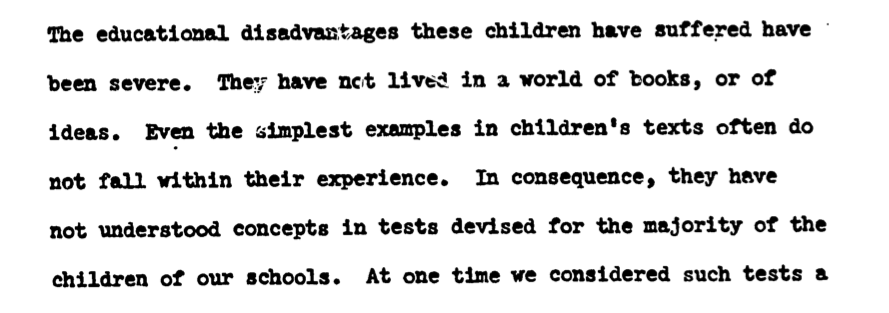Does Congress understand how Title I money was meant to be used? Looking at what they have proposed to date, it is a question in need of a good, clear answer.
A requirement in the original Elementary and Secondary Education Act (ESEA) was that a president-appointed advisory council report yearly to the president. The National Advisory Council on the Education of Disadvantaged Children was to review the laws’ progress with the programs and projects Title I funding supported.
In turn, the president was to report the findings to our Congress along with comments and further recommendations.
To do this responsibly and hold our government “accountable,” we all need to understand Title I. Title I is the touchstone of the original ESEA.
The federal formula funding was distributed to assist “children of low-income families.” The directive was to address the needs of “educationally deprived children,” which the architects understood would include more than just the low-income children given that the schools where the most funds would flow were “inherently unequal.” Needs are going to vary from community to community but potentially all students in schools in low-income communities are at risk for being under-served.
Title I was to address the disadvantages CHILDREN face — economically, educationally, mentally, or physically “disadvantaged”— when their learning needs aren’t being met by state and local agencies.
The goal of ESEA was to provide equal access to quality education — that is how “equal opportunity” was defined.
To do so, we have to recognize the barriers “disadvantaged” students and their families face in our communities, schools, and classrooms and fully address those problems directly. Title I dollars flowed to meet the needs of CHILDREN from low-income families….PERIOD. The other five titles of ESEA addressed the needs of low-income schools, communities, and states.
This is our ESEA history.
In 1966, less than a year into ESEA’s implementation, President Johnson received his first report from the Council. They reviewed and summarized the programs. They gave examples including one district reporting that health examinations had been conducted for the first time showing that 45% of the children tested were anemic.
Now, how do we expect these disadvantaged children to have the same standards-based outcomes at the same time as healthy children?
As President Obama expressed in Selma,
“Americans don’t accept a free ride for anyone, nor do we believe in equality of outcomes. But we do expect equal opportunity,…”
To fulfill our duty to America’s children, effective schools must be established in every community where they do not currently exist. Understanding that those communities with the highest concentrations of poverty have children at greatest risk of being educationally under-served, their needs should be our first priority.
At President Obama’s request, we have identified the lowest performing schools throughout our land. It is our responsibility as a nation to support their improvement, as a short-term goal, while providing a long-term strategy to prevent the wide gaps in opportunities, and therefore educational achievement, that we have experienced in our past and that continues to plague our nation’s children today.
In addition to providing the best in educational opportunities to every child, now is the time for a plan that views appropriation of funds as a national strategic educational investment and expects communities to make wise use of all education resources.
And let it be acknowledged that the urgent need of children begs for some emergency measures.
Let us not lose sight of the purposes of the Elementary and Secondary Education Act (ESEA):
* To establish equal access to quality education,
* To strengthen and improve all schools.
Here’s the beginning of an alternative a plan to what Congress currently (in March of 2015) is cooking up:
Title I – Education of Children of Low Income Families to provide formula-funded financial assistance to local education agencies in support of children from low-income families in order expand and improve community efforts to meet their learning needs.
Execution: To address learning needs requires a “needs assessment.” School staff (principals, counselors, aids, and teachers) and parents (or other adults involved in these high-needs children’s lives) will be the first to collectively identify those needs. Those identified needs will then be brought to the attention of the larger group of community stakeholders (civic, non-profit organizations, foundations and concerned individuals) to be further defined, measures for success indicators established, and existing resources in the community identified. “Gaps” in resources will be identified and brought to the attention of state education officials so that no identified need goes unaddressed. State officials will be responsible for identifying their resources and establishing indicators of their success and to continually monitor and report on their ability to meet their responsibility. Needs assessments will be done using the existing government assessment tools.
Emergency measures: Those Title I schools now designated as chronically low-performing or “priority” schools will be guided through the assessment and improvement processes with cooperative funding (“set aside” Title I money) and staff from the state and local districts with a “support team” provided through the U.S. Department of Education.
Schools identified as chronically low-performing need strong, effective, democratic leadership to take these schools through a successful school improvement process. A federal leadership program (Academy) will be
“designed to enable people who are already experienced principals and other school leaders, knowledgeable about how schools work and the special problems they face, to learn how to turn around the expectations, beliefs and practices of school stakeholders in low-performing schools. The expected focus of the Academy would be on how to improve instruction and change schools’ culture” (Ratner, The “Lead Act,” H.R. 5495/S 3469: Briefing Paper).
Accountability: Using the indicators of success as designated for targeted results through the school improvement process, the “appropriate objective measurements” will be used to judge the “effectiveness of the programs in meeting the special educational needs of educationally deprived children.” Local and state officials will have established the parameters (what and how often) of those measurements and will make those facts transparent to the community and state, respectively. An accounting of expenses and results of the uses of Title I money will be reported to federal officials for review. National monitoring of achievement gaps through the random use of the National Assessment of Educational Progress (NAEP) will continue unchanged. Results of progress by the nation and cost /benefits will be reported annually to the President, Congress, and the Nation.
Title I was focused on meeting children’s needs NOT a test-based accountability system.
Currently, with ESEA reauthorization conversations being more about a “national accountability system” and “choice,” and less about disadvantaged children, I worry that we have lost our way on the march towards equal educational opportunity.
But then I remember — “WE the People” and the “highest of ideals” that were put into law in 1965 — there is hope.
[The preceding was a modified excerpt from addendum 1 of The Crucial Voice of the People, Past and Present: Education’s Missing Ingredient, second edition, by Victoria M. Young, © 2012]




















